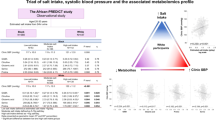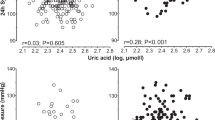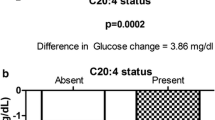Abstract
The prevalence of hypertension in sub-Saharan Africa is increasing rapidly, and treatment remains challenging. Although the use of l-carnitine in treatment has received much attention, studies reporting on physiological l-carnitine levels in hypertensives are limited. Our aim was to determine physiological levels of l-carnitine and acylcarnitines in African and Caucasian men, and to investigate associations between ambulatory blood pressure (BP) and carnitine levels. Participants included 101 African and 101 Caucasian teachers. Ambulatory BP measurements were conducted, and l-carnitine and acylcarnitine levels determined. African men showed significantly higher systolic BP (p < 0.001), diastolic BP (p < 0.001) and l-carnitine levels (p = 0.01). In both ethnic groups, partial regression analyses revealed a positive association between BP and l-carnitine, although in Caucasians it was with systolic (r = 0.20, p = 0.045), and in Africans with diastolic BP (r = 0.23, p = 0.023). After adjusting for confounders, an independent positive association between systolic (R 2 = 0.37, β = 0.12, p = 0.041) and diastolic BP (R 2 = 0.39, β = 0.14, p = 0.018) and l-carnitine and long-chain acylcarnitines (R 2 = 0.38, β = 0.17, p = 0.005 and R 2 = 0.39, β = 0.15, p = 0.011) were found, independent of ethnicity. Physiological l-carnitine levels were not only higher in Africans than in Caucasians but also above the expected reference range. Despite promising results on l-carnitine (and its short-chain derivatives) in hypertension treatment regimens, our findings paradoxically show that elevated BP is significantly associated with higher physiological l-carnitine and long-chain acylcarnitine levels.

Similar content being viewed by others
Abbreviations
- ABPM:
-
Ambulatory blood pressure monitoring
- ATP:
-
Adenosine-5′-triphosphate
- BP:
-
Blood pressure
- cIMT:
-
Carotid intima-media thickness
- CRP:
-
C-reactive protein
- CSWA:
-
Cross-sectional wall area
- ESI–MS/MS:
-
Electrospray ionisation tandem mass spectrometry
- FRAP:
-
Ferric reducing antioxidant power
- GGT:
-
γ-Glutamyl transferase
- HDL:
-
High-density lipoprotein
- LCFA:
-
Long-chain fatty acids
- L-NAME:
-
Nω-nitro-l-arginine methyl ester
- MAP:
-
Mean arterial pressure
- OCTN2:
-
Organic cation transporter 2
- PPARα:
-
Peroxisome proliferator-activated receptor α
- ROS:
-
Reactive oxygen species
- SABPA study:
-
Sympathetic activity and ambulatory blood pressure in Africans study
References
Opie LH, Seedat YK (2005) Hypertension in sub-Saharan African populations. Circulation 112:3562–3568
Addo J, Smeeth L, Leon DA (2007) Hypertension in sub-saharan Africa: a systematic review. Hypertension 50:1012–1018
Mate A, Miguel-Carrasco J, Monserrat MT, Vázquez CM (2010) Systemic antioxidant properties of l-carnitine in two different models of arterial hypertension. J Physiol Biochem 66:127–136
Rauchová H, Dobesová Z, Drahota Z, Zicha J, Kunes J (1998) The effect of chronic l-carnitine treatment on blood pressure and plasma lipids in spontaneously hypertensive rats. Eur J Pharmacol 342:235–239
Gómez-Amores L, Mate A, Revilla E, Santa-María C, Vázquez CM (2006) Antioxidant activity of propionyl-l-carnitine in liver and heart of spontaneously hypertensive rats. Life Sci 78:1945–1952
Gómez-Amores L, Mate A, Miguel-Carrasco J, Jiménez L, Jos A, Cameán AM, Revilla E, Santa-María C, Vázquez CM (2007) l-carnitine attenuates oxidative stress in hypertensive rats. J Nutr Biochem 18:533–540
O’Brien D, Chunduri P, Iyer A, Brown L (2010) l-carnitine attenuates cardiac remodelling rather than vascular remodelling in deoxycorticosterone acetate-salt hypertensive rats. Basic Clin Pharmacol Toxicol 106:296–301
Ruggenenti P, Cattaneo D, Loriga G, Ledda F, Motterlini N, Gherardi G, Orisio S, Remuzzi G (2009) Ameliorating hypertension and insulin resistance in subjects at increased cardiovascular risk: effects of acetyl-l-carnitine therapy. Hypertension 54:567–574
Miguel-Carrasco J, Monserrat MT, Mate A, Vázquez CM (2010) Comparative effects of captopril and l-carnitine on blood pressure and antioxidant enzyme gene expression in the heart of spontaneously hypertensive rats. Eur J Pharmacol 632:65–72
Mate A, Miguel-Carrasco J, Vázquez CM (2010) The therapeutic prospects of using l-carnitine to manage hypertension-related organ damage. Drug Discov Today 15:484–492
Sharma S, Black SM (2009) Carnitine homeostasis, mitochondrial function and cardiovascular disease. Drug Discov Today Dis Mech 6:e31–e39
Barger PM, Kelly DP (2000) PPAR signaling in the control of cardiac energy metabolism. Trends Cardiovasc Med 10:238–245
Hojo Y, Noma S, Ohki T, Nakajima H, Satoh Y (1997) Autonomic nervous system activity in essential hypertension: a comparison between dippers and non-dippers. J Hum Hypertens 11(10):665–671
International Society for the advancement of Kinanthropometry (ISAK) (2001) International standards for anthropometric assessment. National library of Australia, Adelaide
Mancia G, De Backer G, Dominiczak A, Cifkova R, Fagard R, Germano G, Grassi G, Heagerty AM, Kjeldsen SE, Laurent S (2007) Guidelines for the management of arterial hypertension: The Task Force for the Management of Arterial Hypertension of the European Society of Hypertension (ESH) and of the European Society of Cardiology (ESC). J Hypertens 25:1105–1187
Hannon WH, Whitley RJ, Davin B, Fernhoff P, Halonen T, Lavochkin M, Miller J, Ojodu J, Therrell BL (2007) Blood collection on filter paper for newborn screening programs; approved standard. Clin Lab Stand Inst 23(21):1–33
Hayashi I, Morishita Y, Imai K, Nakamura M, Nakachi K, Hayashi T (2007) High-throughput spectrophotometric assay of reactive oxygen species in serum. Mutat Res 631:55–61
Benzie IF, Strain JJ (1996) The ferric reducing ability of plasma (FRAP) as a measure of “antioxidant power”: the FRAP assay. Anal Biochem 239:70–76
Chace DH, Hillman SL, Van Hove JL, Naylor EW (1997) Rapid diagnosis of MCAD deficiency: quantitative analysis of octanoylcarnitine and other acylcarnitines in newborn blood spots by tandem mass spectrometry. Clin Chem 43:2106–2113
Reuter SE, Evans AM, Chace DH, Fornasini G (2008) Determination of the reference range of endogenous plasma carnitines in healthy adults. Ann Clin Biochem 45:585–592
Nakamura T, Sugihara H, Kinoshita N, Ito K, Adachi Y, Hirasaki S, Matsuo A, Azuma A, Kodo N, Nakagawa M (1999) Serum carnitine concentrations in patients with idiopathic hypertrophic cardiomyopathy: relationship with impaired myocardial fatty acid metabolism. Clin Sci (Lond) 97:493–501
Nakamura T, Sugihara H, Kinoshita N, Yoneyama S, Azuma A, Nakagawa M (2000) Can serum carnitine levels distinguish hypertrophic cardiomyopathy from hypertensive hearts? Hypertension 36:215–219
Foster KA, O’Rourke B, Reibel DK (1985) Altered carnitine metabolism in spontaneously hypertensive rats. Am J Physiol 249:E183–E186
Rebouche CJ (2004) Kinetics, pharmacokinetics, and regulation of l-carnitine and acetyl-l-carnitine metabolism. Ann NY Acad Sci 1033:30–41
Flanagan JL, Simmons PA, Vehige J, Willcox MDP, Garrett Q (2010) Role of carnitine in disease. Nutr Metab 7:30–44
Vorster HH, Venter CS, Wissing MP, Margetts BM (2005) The nutrition and health transition in the North West Province of South Africa: a review of the THUSA (Transition and Health during Urbanisation of South Africans) study. Public Health Nutr 8:480–490
Vaz FM, Wanders RJA (2002) Carnitine biosynthesis in mammals. Biochem J 361:417–429
Rudman D, Sewell CW, Ansley JD (1977) Deficiency of carnitine in cachectic cirrhotic patients. J Clin Invest 60:716–723
Palombo JD, Borum PR, Jenkins RL, Bistrian BR (1989) Blood carnitine status after othotopic liver transplantation in patients with end-stage liver disease. Am J Clin Nutr 50:504–507
Kratz A, Ferraro M, Sluss PM, Lewandroski KB (2004) Laboratory reference values. N Engl J Med 351:1548–1563
Ringseis R, Eder K (2009) Influence of pharmacological PPARα activators on carnitine homeostasis in proliferating and non-proliferating species. Pharmocol Res 60:179–184
Poynter ME, Daynes RA (1998) Peroxisome proliferator-activated receptor alpha activation modulates cellular redox status, represses nuclear factor-kappa B signaling, and reduces inflammatory cytokine production in aging. J Biol Chem 273:32833–32841
Maeda T, Wakasawa T, Funabashi M, Fukushi A, Fujita M, Motojima K, Tamai I (2008) Regulation of Octn2 transporter (SLC22A5) by peroxisome proliferator activated receptor alpha. Biol Pharm Bull 31:1230–1236
Tamai I, Ohashi R, Nezu J, Yabuuchi H, Oku A, Shimane M, Sai Y, Tsuji A (1998) Molecular and functional identification of sodium ion-dependent, high affinity human carnitine transporter OCTN2. J Biol Chem 273:20378–20382
Grube M, Ameling S, Noutsias M, Köck K, Triebel I, Bonitz K, Meissner K, Jedlitschky G, Herda LR, Reinthaler M, Rohde M, Hoffmann W, Kühl U, Schultheiss HP, Völker U, Felix SB, Klingel K, Kandolf R, Kroemer HK (2011) Selective regulation of cardiac organic cation transporter novel type 2 (OCTN2) in dilated cardiomyopathy. Am J Pathol 178:2547–2559
Shah SH, Hauser ER, Bain JR, Muehlbauer MJ, Haynes C, Stevens RD, Wenner BR, Dowdy ZE, Granger CB, Ginsburg GS, Newgard CB, Kraus WE (2009) High heritability of metabolomic profiles in families burdened with premature cardiovascular disease. Mol Syst Biol 5:1–7
Mogensen CE (2002) Microalbuminuria in perspectives. In: Friedman EA, L’Esperance FA (eds) Diabetic renal-retinal syndrome: pathogenesis and management update. Kluwer, London
Acknowledgments
The Sympathetic Activity and Ambulatory Blood Pressure in Africans (SABPA) Study would not have been possible without the voluntary collaboration of the participants and the Department of Education, North-West Province, South Africa. We gratefully acknowledge the technical assistance of Mrs. Tina Scholtz, Dr Szabolcs Péter and Sr Chrissie Lessing. This study was supported by the National Research Foundation, South Africa; the North-West University, Potchefstroom, South Africa, and the Metabolic Syndrome Institute, France.
Conflict of interest
The authors declare no conflict of interest. This study was supported by the National Research Foundation, South Africa; the North-West University, Potchefstroom, South Africa; and the Metabolic Syndrome Institute, France.
Author information
Authors and Affiliations
Corresponding author
About this article
Cite this article
Mels, C.M.C., Schutte, A.E., Erasmus, E. et al. l-Carnitine and Long-Chain Acylcarnitines are Positively Correlated with Ambulatory Blood Pressure in Humans: The SABPA Study. Lipids 48, 63–73 (2013). https://doi.org/10.1007/s11745-012-3732-8
Received:
Accepted:
Published:
Issue Date:
DOI: https://doi.org/10.1007/s11745-012-3732-8




